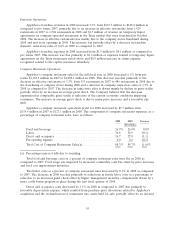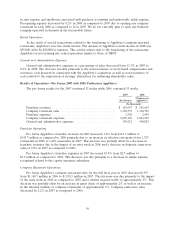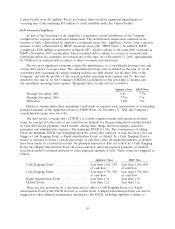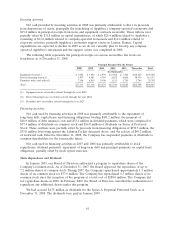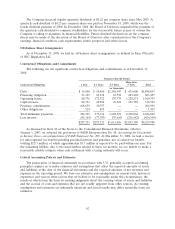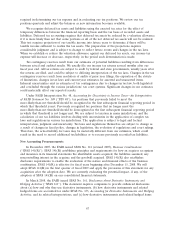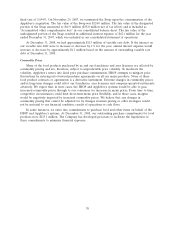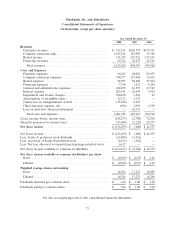IHOP 2008 Annual Report Download - page 77
Download and view the complete annual report
Please find page 77 of the 2008 IHOP annual report below. You can navigate through the pages in the report by either clicking on the pages listed below, or by using the keyword search tool below to find specific information within the annual report.We believe the following critical accounting policies require us to make significant judgments and
estimates in the preparation of our consolidated financial statements:
Purchase Price Allocation
The purchase price for acquisitions is allocated to the identifiable tangible and intangible assets
acquired and liabilities assumed based on their respective fair values in accordance with Statement of
Financial Accounting Standards (‘‘SFAS’’) No. 141, Business Combinations (‘‘SFAS 141’’). The
determination of estimated fair values of identifiable intangible assets and certain tangible assets
requires significant estimates and assumptions, including but not limited to, determining the estimated
future cash flows, estimated useful lives of assets and appropriate discount rates. We believe the
estimated fair values assigned to the Applebee’s assets acquired and liabilities assumed are based on
reasonable assumptions. However, the fair value estimates for the purchase price allocation may change
during the allowable allocation period under SFAS 141, which is up to one year from the acquisition
date, if additional information becomes available that would require changes to our estimates.
Long-Lived Assets
We assess long-lived and intangible assets with finite lives for impairment when events or changes
in circumstances indicate that the carrying value of the assets may not be recoverable. We test
impairment using historical cash flows and other relevant facts and circumstances as the primary basis
for our estimates of future cash flows. We consider factors such as the number of years the restaurant
has been operated by us, sales trends, cash flow trends, remaining lease life, and other factors which
apply on a case-by-case basis. The analysis is performed at the individual restaurant level for indicators
of permanent impairment. Recoverability of the restaurant’s assets is measured by comparing the assets’
carrying value to the undiscounted cash flows expected to be generated over the assets’ remaining
useful life or remaining lease term, whichever is less. If the total expected undiscounted future cash
flows are less than the carrying amount of the assets, the carrying amount is written down to the
estimated fair value, and a loss resulting from impairment is recognized by charging to earnings. This
process requires the use of estimates and assumptions, which are subject to a high degree of judgment.
If these assumptions change in the future, we may be required to record impairment charges for these
assets.
Goodwill and Intangibles
Goodwill is recorded when the aggregate purchase price of an acquisition exceeds the estimated
fair value of the net identified tangible and intangible assets acquired. Intangible assets resulting from
the acquisition are accounted for using the purchase method of accounting and are estimated by
management based on the fair value of the assets received. Identifiable intangible assets are comprised
primarily of trademarks, trade names and franchise agreements. Identifiable assets are being amortized
over the period of estimated benefit using the straight-line method and estimated useful lives. Goodwill
and indefinite life intangible assets are not subject to amortization.
In accordance with SFAS No. 142, Goodwill and Other Intangible Assets (‘‘SFAS 142’’), goodwill has
been allocated to three reporting units, the IHOP franchised restaurants unit (‘‘IHOP unit’’),
Applebee’s company-operated restaurants unit (‘‘Applebee’s company unit’’) and Applebee’s franchised
restaurants unit (‘‘Applebee’s franchise unit’’). The significant majority of the Company’s goodwill
resulted from the November 29, 2007 acquisition of Applebee’s and has been allocated between the
two Applebee’s units. The Company tests goodwill and other indefinite life intangible assets for
impairment on an annual basis in the fourth quarter. The impairment test of goodwill of the two
Applebee’s units was performed as of October 31, 2008. The impairment test of the goodwill of the
IHOP unit was performed as of December 31, 2008, the date as of which the analysis has been
performed in prior years. In addition to the annual test of impairment, goodwill must be evaluated
63




